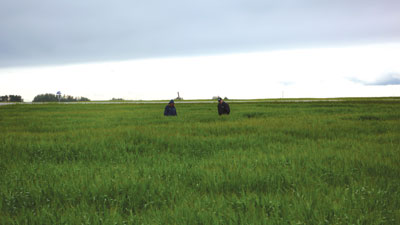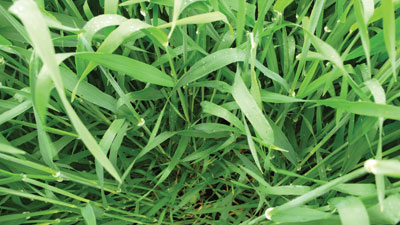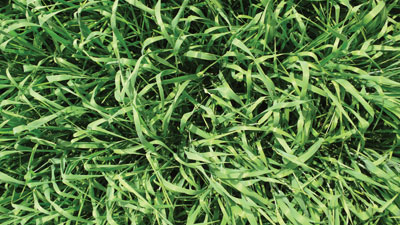
Features
Agronomy
Diseases
Establishing a barley leaf disease risk assessment tool
Assessing cereal leaf diseases and making the decision of whether or not to spray can be a difficult one. There are few tools available to producers or agronomists that have been developed based on objective long-term research information.
April 30, 2010 By Donna Fleury
Assessing cereal leaf diseases and making the decision of whether or not to spray can be a difficult one. There are few tools available to producers or agronomists that have been developed based on objective long-term research information.
Researchers at the Agriculture and Agri-Food Canada (AAFC) Research Centre in Lacombe, Alberta, are trying to develop a simpler risk assessment tool for barley leaf diseases. “We are looking at adding to the tool box that farmers, crop scouts or agronomists can use to more easily assess the risk of cereal leaf diseases,” explains Dr. Kelly Turkington, research scientist. “We are trying to understand the nature of some of these leaf diseases such as scald and net blotch particularly in barley, how the disease develops, and use that information to develop rules of thumb for risk.”
Turkington recognizes that farmers and agronomists with several years of experience of field scouting and keeping on top of issues in their fields will already be able to make reasonable assessment of risk and whether or not to spray. “We hope this new tool will add to their toolbox and combined with their knowledge of the field history, the variety and its resistance package and weather conditions, will make the decision of whether or not to spray a little easier,” says Turkington.
 |
|
| Noryne Rauhala, Agriculture and Agri-Food Canada (AAFC), Lacombe, Alberta, and Jack Payne, Olds College, Olds, Alberta, surveying a barley field at the heading stage in the Didsbury area of Alberta, July 2008. |
|
 |
|
| A barley field in the flag leaf emergence stage, Didsbury area of Alberta, July 2008. |
|
 |
|
| A barley plot approaching flag leaf emergence, AAFC Lacombe, July 2008. |
Barley leaf disease risk assessment tool
The upper canopy of a barley field is very important in terms of grain filling and yield, therefore the focus is on protecting the upper leaves in that crop canopy. Recently the staff from the pathology program at Lacombe has been conducting surveys in commercial barley fields just prior to or at flag leaf emergence and again later at the early dough stage. “We have done some assessments of disease levels, trying to keep in mind the requirements that farmers, crop scouts and agronomists might have,” says Turkington. “We know their time is limited, and they need to be able to get out in a field and perform a quick but reasonable assessment of the risk and then move on to another field.”
Taking those factors into consideration, researchers have selected one parameter that seems to be showing some promise. It is based on some earlier research and risk assessment strategies for irrigated wheat in Saskatchewan developed by Lorne Duczek, a retired AAFC plant pathologist. “For barley leaf disease risk assessment, we are looking at the area of the third leaf down from the head and assessing the percentage of area that is affected,” explains Turkington. “Our preliminary research data shows that if there is less than about one to two percent of the area of the third leaf down affected by net blotch or scald, in all likelihood the risk of an economic level of disease is lower and as a consequence farmers probably don’t need to spray a fungicide.”
Turkington cautions that this “rule of thumb” is based on preliminary information, and researchers want to validate it over a larger geographic area and during the course of several years to confirm the accuracy. “We think this “rule of thumb” assessment tool will add to the toolbox as far as helping producers, crop scouts and agronomists come up with an assessment that they feel comfortable with and that fits in their time schedules,” says Turkington. The assessment reflects the amount of disease development that has occurred and has potential to aid in the decision of whether or not to spray. “We believe this tool can be integrated into a normal inspection program that an agronomist or producer uses to try and stay on top of the issues in their fields,” adds Turkington.
The assessment will take about 30 to 45 minutes and will give them some information to help make a decision that is based on more of a scientific background.
Assessing disease level is the goal
Turkington emphasizes that they are not trying to predict the actual level of the disease that is going to occur later in the season. The assessment tool is trying to help find a threshold level below which, under average conditions, a grower is unlikely to see the development of an economic level of the disease that would warrant a fungicide application.
The timelines for most foliar fungicide applications are up to half the head emerged. If a risk assessment is done at or just prior to the flag leaf stage and if the disease level is less than one to two percent, then look at the variety, the weather forecasts and go back to that field in five to seven days to reassess the level of disease development, especially if previous conditions have been dry. “If all of a sudden you have an ultra susceptible variety and some very conducive weather conditions develop to cycle the disease, then it is definitely something that needs to be looked at,” says Turkington. “Look at the flag leaf stage, then go back in five to 10 days and scout the field again. Depending on the growth stage, timing, weather and the level of disease found, then go out and monitor that field again.”
This appears to be good advice based on preliminary results from 2009 when very dry conditions in May and June limited disease development prior to the flag leaf emergence stage. Turkington and colleagues found that subsequent weather conditions favoured disease development after the flag leaf emergence stage.
Turkington plans to validate this barley leaf disease risk assessment tool during the next few seasons, and welcomes input and feedback from growers, crop scouts and agronomists on how well it works. “We expect this tool may eventually be integrated with weather forecasting to further help assess the risk and the need to spray. If the weather indicates an extremely low risk of disease development, then spraying may not be critical, however it is still very important to keep on top of what is happening in the field, whether it be disease, weed or insect problems.”